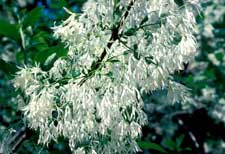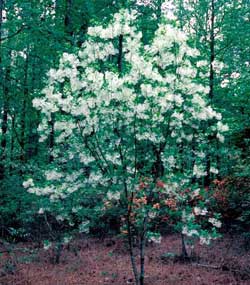Landscape Shrubs
Fringetree
(Chionanthus virginicus)
Fringetree (Chionanthus) is a large, flowering shrub. It comes in two varieties—our native species, Chionanthus virginicus, and the equally dramatic species C. retusus from Eastern Asia.
Our native white fringetree, also known as Grancy Gray-beard or Old Man’s Beard, blooms in mid-April. The large shrub stands out with its billowy soft plume of pure white flowers. Up close, the panicles are composed of narrow, white petals. Fringetree is certainly an appropriate name. Flowers appear as the new foliage is emerging, so the plant appears white; but as the new, light-green leaves emerge, they soften the stark white petals with pastels of green.
The fruits are not worth mentioning except as a way to tell these two species apart. Since flowers on white fringetree appear on last year’s wood, the fruits develop toward the interior of the shrub and are usually hidden by the foliage. In contrast, flowers on the Chinese fringetree develop on new growth, so the fruits appear at the end of stems and well outside the foliage. Chionanthus is a dioecious plant, so fruits appear only on female plants. Fruits in either species are not dramatic since they are dark, almost blue-black. The drupe, which is approximately ½” long and oval in shape, matures in early fall.
Leaves on white fringetree are lawn-green, elliptical in shape, and usually 5–8” long. Although some plants do have yellow fall color, it is not reliable for fall color. The White fringetree is adaptable to full sun or full shade; shade plants tend to be more open. There should be no significant insect or disease problems.
There appear to be two different plant habits, and some have suggested that this related to sex of the plant. The plant habit is either a large, very open, almost gangly shrub, or plants have a better-behaved, tight, upright habit.
Chinese fringetree tends to flower about two weeks later than white fringetree. In central Arkansas, flowers usually appear the last week of April or early May. Plants still offer the showy, fleecy, white flowers, but in this case they are born at the end of branches with a backdrop of dark, glossy green leaves. The contrast makes the flower display even more dramatic. Leaves on the Chinese fringetree are a more rounded elliptical and so glossy that they almost appear polished. The leaves typically drop in December.
Mature plants usually develop multiple trunks with a mature height of 18’ and a spread of 25’. The bark is an attractive light gray with plates and black furrows. It is adaptable to full sun or full shade and has no insect or disease problems.
- Common Name: fringetree
- Varieties to look for: none
- Flower color: snow white (showy)
- Blooming period: mid-April
- Type: deciduous shrub
- Size: large shrub or small tree; 15’ tall x 15’ wide
- Exposure: sun to shade
- Soil: fairly tolerant
- Watering: moist best
- When to prune: after flowering
- Suggested use: mixed shrub bed, woodland garden
Flowers

Fringetree form with flowers
